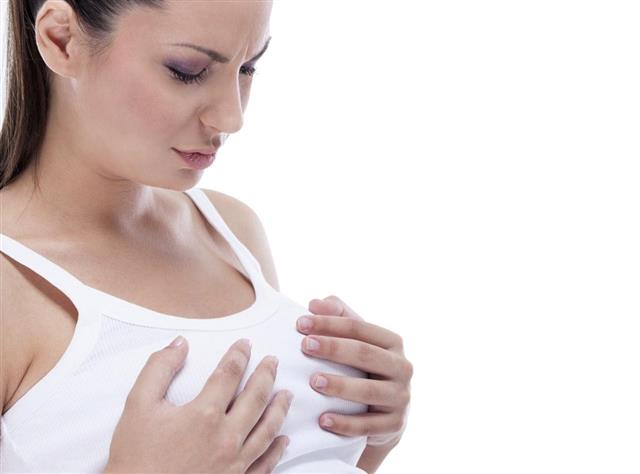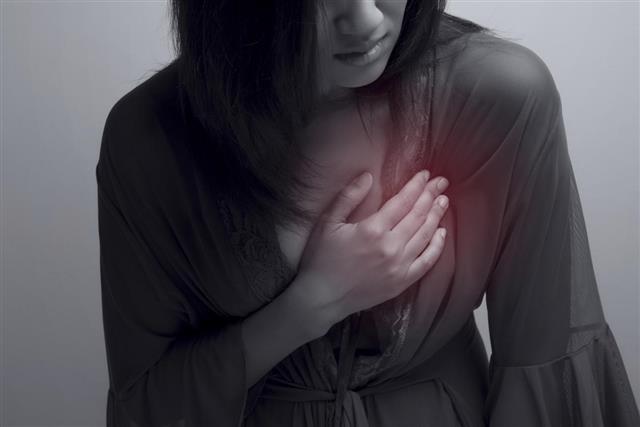
Pain under the right breast could be referred from the organs located in the right side of the abdomen. Medical conditions associated with the liver, pancreas, gallbladder, or kidneys could be contributing factors for pain below the right breast. The following write-up provides information on the common causes of pain around the right breast.
Pain below the right breast could be associated with an injury or a medical condition that gives rise to inflammation of the bones, muscles, or cartilage in the chest cavity. At times, it’s extremely difficult to pinpoint the location of the pain.
Pain that is felt by the affected individual could occur due to sore intercostal muscles, muscle spasms, cracked ribs, inflamed costal cartilage, acid reflux, hiatal hernia, inflamed pleura, excessive gas, etc.
At times, pain may be felt at an area other than the place of its origin or the site of the stimulus.
It could be referred from the pancreas, gallbladder, liver, or the right kidney, as these are located in the right upper quadrant of the abdomen. Medical assistance must therefore be sought if pain persists.
Contributing Factors
Pain below the right breast could be caused due to a wide range of reasons. Here are some of the medical conditions that may cause pain in this region.
Rib Injury
The rib cage is a bony structure that comprises the ribs, sternum, costal cartilages, and thoracic vertebrae. The ribs or the sternum could develop cracks or get fractured due to blunt force trauma. Physical assault (a hard blow to the chest), crush injuries wherein a heavy object lands on the chest, falls, or motor vehicle accidents could cause rib injuries. Even the muscles that lie within the rib cage could get strained if they are stretched beyond the tolerable limit.
Rib injuries usually cause pain and tenderness over the affected area. Pain may worsen while coughing, sneezing, or taking deep breaths.
Costochondritis
The term ‘costochondritis’ refers to inflammation at the junction, where the costal cartilages attach the ends of the ribs to the breastbone. Trauma to the chest, repetitive strain injuries, bacterial, viral or fungal infections of costosternal joint, or violent coughing could cause costochondritis. The characteristic sign of this condition is chest pain that could get aggravated with physical activity. Pain may also worsen with sneezing or coughing.
Pancreatitis
Pancreas is a glandular organ which is located behind the stomach. The wide end or the head of the pancreas is located on the right side of the abdomen. The term ‘pancreatitis’ refers to the inflammation of pancreas. Pancreatitis could be acute or chronic. Inflammation could occur due to infections, excessive consumption of alcohol, blockage of pancreatic duct or the common bile duct, elevated levels of triglycerides, cholelithiasis (presence of gallstones), etc.
Pain may get referred to the area under the right breast from inflamed pancreas. Pain that may radiate to the sides or the back, tenderness of the abdomen, vomiting, nausea, fever, and bloating are some of the symptoms of pancreatitis. These symptoms may worsen after the consumption of a fatty meal.
Gallbladder Disease
Gallbladder is a pear-shaped sac that is located under the liver in the right upper quadrant of the abdomen. It stores and releases bile, which is a digestive juice that is produced by the liver. Bile contains bile salts, bile pigments, and cholesterol. Cholelithiasis, which refers to the presence of gallstones in the gallbladder, is a condition that occurs due to crystallization of cholesterol or bile pigments.
The affected individual is likely to experience a sharp or dull pain in the upper right abdomen. Pain may also radiate to the back. The other symptoms that may be experienced by affected individuals include nausea, vomiting, fever, etc. At times, cholelithiasis could lead to cholecystitis (inflammation of the gallbladder).
Kidney Stones
Kidney stones, which are medically referred to as renal calculi, are hard, stone-like deposits that form due to crystallization of minerals and acid salts present in urine. While small kidney stones may pass through the urinary tract, excruciating pain may be felt when large kidney stones get lodged in the kidney or the ureter.
Flank pain is one of the most common symptoms of kidney stones. If the right kidney is affected by a kidney stone, pain could radiate to the lower right section of the rib cage. The affected individual may experience symptoms such as nausea, vomiting, fever, frequent urge to urinate, cloudy urine, or burning sensation while urinating.
Hiatal Hernia
Hiatal hernia refers to the protrusion of a part of the stomach through the hiatal opening into the thoracic cavity. Esophageal hiatus is a small opening in the diaphragm through which the esophagus and the vagus nerve pass. This opening is large enough to allow the esophagus to pass through, but if it is larger than its usual size, then a part of the stomach could protrude from the opening towards the chest.
Heartburn, shortness of breath, bloating after meals, and chest pain that radiates from below the sternum are some of the common symptoms of hiatal hernia.
Pleurisy
Pleurisy refers to the inflammation of the pleura. The pleura is a serous membrane that lines the lungs and the walls of the chest cavity. Upper respiratory infections, pneumonia, exposure to asbestos or other toxic substances, and trauma to the chest are some of the contributing factors for pleurisy.
The characteristic sign of pleurisy is chest pain that worsens with movement. Pain could also worsen while coughing or taking deep breaths. Shortness of breath, coughing and rapid breathing are other symptoms that may be experienced by the affected individuals.
Besides the aforementioned medical conditions, pain may occur due to acid reflux disease, muscle spasms, or liver damage. The symptoms that may accompany pain would vary, depending on the underlying cause of pain. If the pain persists, consult a doctor immediately, so as to identify the medical condition that may be responsible for causing pain under the right breast.
Disclaimer: The information provided in this article is solely for educating the reader. It is not intended to be a substitute for the advice of a medical expert.


